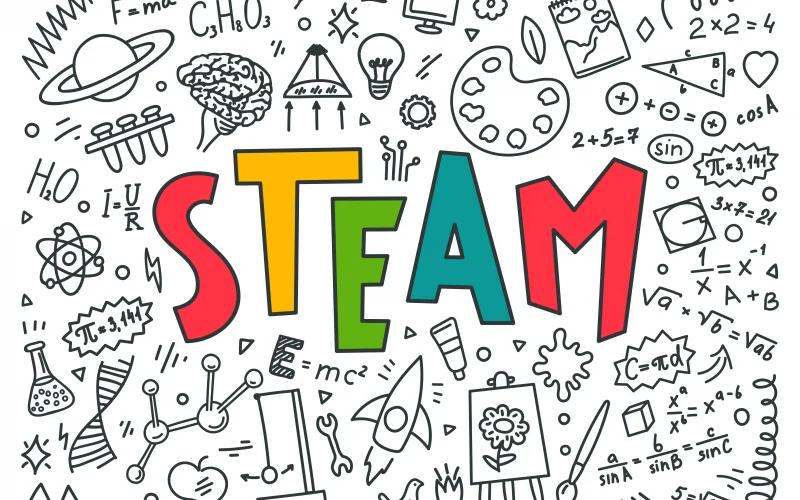Maybe you remember school as a bunch of separate subjects – science over here, history over there, and art class feeling totally different. But what if learning could be more connected, more like building a giant amazing project? That’s the idea behind STEAM education! The steam curruclum!
STEAM stands for Science, Technology, Engineering, Arts, and Math. Instead of learning these subjects in isolation, STEAM smashes them together in a fun and creative way. Imagine building a model volcano in science class, then designing a poster about it in art class – that’s STEAM in action!
This article is your guide to understanding STEAM. We’ll break down everything you need to know about STEAM, from what it is to why it’s so awesome.
Table of contents
What Is STEAM Curriculum?
The term STEAM is an acronym for Science, Technology, Engineering, Arts, and Mathematics.
Unlike traditional education that focuses on teaching these subjects in isolation, the STEAM curriculum integrates them into a cohesive and interdisciplinary approach to learning.
By blending these disciplines, STEAM education encourages critical thinking, problem-solving, collaboration, and creativity among students.
Read Also: Should College Be Free: YES/NO? Pros And Cons
What Are The Key Components Of A Steam Curriculum?
A STEAM curriculum is an educational approach that integrates the disciplines of science, technology, engineering, art, and mathematics.
Each discipline works together to help students develop a deep understanding of each subject and encourages creative problem-solving.
The critical components of a STEAM curriculum are:
1. Hands-on learning experiences – Students should be encouraged to explore the various disciplines through hands-on activities such as building models, creating projects, and working in teams. This allows them to develop skills in all areas of the STEAM disciplines.
2. Cross-disciplinary collaboration – Working together in teams helps students to apply their knowledge from one discipline to another and encourages collaboration between different subjects.
3. Technology integration – Incorporating technology into the classroom can help students understand how different technologies work together and how they can be used to solve problems in each discipline.
Read Also: What Happens During College Orientation? Guiding Tips
Why is STEAM Education Important?
STEAM education is important because it breaks down the barriers between traditionally separate subjects. This allows students to see how these subjects connect and work together in the real world.
Imagine using math skills to design a bridge in science class, or using art to create a comic book about historical events. These connections make learning more engaging and meaningful.
STEAM also encourages creativity and problem-solving. By combining different disciplines, students learn to approach challenges from multiple angles and come up with innovative solutions.
This is a crucial skill for success in today’s world, where the ability to think creatively and adapt is becoming increasingly important.
Is STEAM better than STEM?
STEAM education isn’t necessarily better than STEM, but it builds upon it. Imagine STEM as a strong foundation in science, technology, engineering, and math. These are essential skills for many careers and areas of study. STEAM takes that foundation and adds a layer of creativity and artistic expression.
Think of it like building a house. A strong foundation (STEM) is crucial, but it’s the creative touches (arts) that make the house feel unique and inviting. In the same way, STEAM education encourages students to use their scientific and technical knowledge in innovative ways, incorporating artistic expression and design thinking.
This can lead to a deeper understanding of the subjects themselves. For example, creating a musical instrument in science class can make physics concepts like sound waves more engaging. Ultimately, both STEAM and STEM approaches are valuable, and the best choice might depend on the specific learning goals and interests of the student.
Also, read: Are Grammar Schools Better? The Pros and Cons of Grammar Schools
What Are The Benefits of Steam Education?
Here are some of the benefits of going through a STEAM college. Take time to go through it.
Enhancing Critical Thinking Skills
Incorporating STEAM into education fosters critical thinking skills in students. The interdisciplinary nature of STEAM encourages learners to analyze complex problems, identify patterns, and develop innovative solutions.
Students learn to think critically and approach challenges from various perspectives by engaging in hands-on activities and real-world applications.
Promoting Creativity and Innovation
STEAM education provides a platform for nurturing creativity and innovation. Combining art and design with science and technology encourages students to think outside the box and explore unconventional solutions.
This approach helps develop a mindset that values creativity and embraces innovation, essential skills in a rapidly evolving world.
Encouraging Collaboration and Teamwork
Teamwork and collaboration are integral parts of STEAM education. Through group projects and activities, students learn to work together, leverage each other’s strengths, and solve problems collectively.
Collaborative learning experiences in STEAM foster effective communication, empathy, and respect for diverse perspectives.
Developing Problem-Solving Skills
STEAM education empowers students with strong problem-solving skills. Hands-on projects teach Students to apply scientific and mathematical concepts to real-life situations.
They develop the ability to identify problems, break them into manageable components, and devise innovative solutions. These problem-solving skills are transferable to various areas of life and are highly valued in today’s workforce.
Read Also: Scottish Curriculum: An Overview of the Scottish Education System
Preparing for Future Careers
In a world increasingly driven by technology and innovation, STEAM education equips students with the skills necessary for future careers.
Integrating science, technology, engineering, arts, and mathematics prepares students to tackle the challenges of the 21st-century job market.
STEAM graduates are well-positioned to pursue engineering, computer science, architecture, design, and more careers.
Fostering a Love for Learning
One of the critical benefits of STEAM education is its ability to foster a love for learning. By engaging students in hands-on and experiential activities, STEAM makes learning exciting and relevant.
Students are more likely to develop a passion for subjects when they see their practical applications. This enthusiasm for learning carries forward into their academic and professional lives.
Read Also: What to Wear to a College in the USA: Dress Code Tips & Ideas
FAQs
STEAM education is suitable for learners of all ages, from early childhood to adulthood. It can be adapted to different levels and tailored to meet the needs of various age groups.
STEAM curriculum benefits students with different learning styles by offering diverse avenues for engagement. Visual learners can explore through art and design, auditory learners can engage in discussions, and kinesthetic learners can participate in hands-on experiments and activities.
Implementing STEAM education does not necessarily require expensive tools or resources. It can be integrated into the curriculum using readily available materials and digital resources. The focus is on creativity, critical thinking, and problem-solving rather than solely relying on expensive equipment.
No, STEAM education does not neglect other subjects. It emphasizes the integration of science, technology, engineering, arts, and mathematics while incorporating other disciplines. STEAM education promotes a well-rounded and holistic approach to learning.
Absolutely! STEAM education can be incorporated into homeschooling. Parents can integrate STEAM principles into their teaching methodologies, creating hands-on projects and encouraging exploring various disciplines.
Yes, there are numerous real-world examples of successful STEAM education implementation. For instance, schools and institutions such as the Massachusetts Institute of Technology (MIT) Media Lab have embraced STEAM principles and witnessed positive outcomes in student engagement, creativity, and problem-solving abilities.
Conclusion
The STEAM curriculum offers a fresh and dynamic approach to education.
Integrating science, technology, engineering, arts, and mathematics gives students the tools they need to succeed in the 21st century.
From enhancing critical thinking and problem-solving skills to fostering creativity, collaboration, and innovation, STEAM education empowers learners to become well-rounded individuals ready to tackle future challenges.
References
- cie.spacefoundation.com – What Is STEAM Education and Why Is It Important?
- artsintegration.com – What is STEAM Education?
- alleducationschool.com – Resources for Current & Future STEAM Educators




